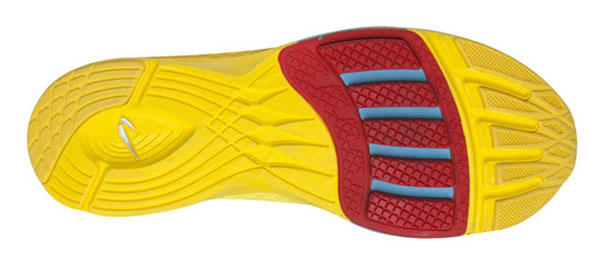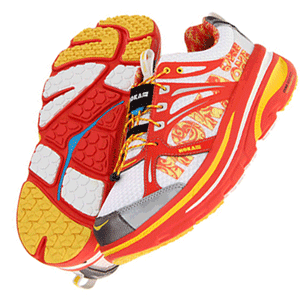Future of Run Footwear
Two footwear brands have an outsized loyalty among triathletes: Newton and Hoka One One. I say outsized because if you look at polling, at least among Slowtwitchers, the rate of use of these brands way outstrips the revenues of these brands compared to sales of larger companies (Brooks, Asics, Nike, Adidas, New Balance) making technical running footwear.
I’m going to use these two companies as proxies for where I think the running market is going, because they each are making shoes that exhibit some or most of the important features elbowing their way into technical running.
Fulcrum-themed outsole geometry
For years the feature I kept seeing in running shoes was the flex groove. This determined how and where the shoe would flex, and it also identified both a hinge in the shoe and the fulcrum around which the shoe would pivot from plant to push-off. Asics rethought this, and last year I saw a review of the Gel Lyte 33 by our footwear editor Jeroen Van Geelen and I thought this was pretty insightful of Asics. That august company properly recognized that we don’t move back to front on the shoe as we run, rather we move at an angle, via natural pronation, from the lateral side of the heel to the medial side of the forefoot. Asics introduced a theme it calls “FluidAxis” and it places the flex grooves at an angle, so that the shoe hinges in a way that corresponds to how we actually run. I thought that was clever.
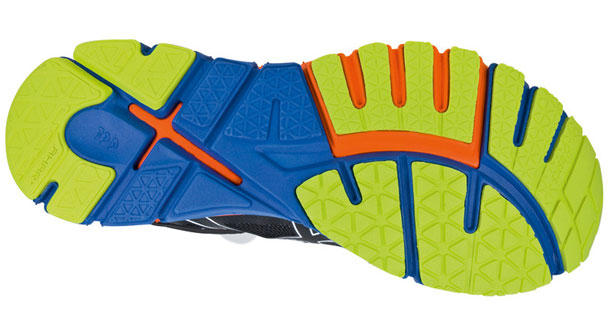
Hoka and Newton each recognize the importance of how and where you translate from plant to push. Each company takes this concept of fulcrum or bending moment or hinge or pivot or whatever you want to call it very seriously. You might even say it’s at the core of each company’s reason for existing. Yes, each company has other features it touts, but in Hoka’s case it shouts loudly about its “Meta Rocker” geometry lest it gets eclipsed by the obvious features such as, most notably, those huge midsoles. When you start talking to Hoka engineers about the “fulcrum” in their shoes you’re talking their language. They engineer each model with a specific fulcrum in mind, and that fulcrum determines how much time your foot spends on the ground.
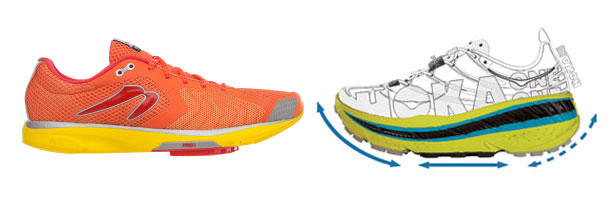
Newton’s lugs are, it seems to me, an analogous concept to Hoka’s Meta Rocker. Everything sexy about the footfall happens at the point of the lug, according to Newton, and I agree. It’s not that I think what happens at the heel is beside the point, rather that it’s secondary to what happens at the lug, which is under the forefoot plant. The lugs work when you weight them, and you pivot from them.
I think Altra is barking up the same tree as Hoka and if you look at a side view of its Olympus you don’t see a flat shoe, you see a shoe that seems to have a built-in hinge in its geometry. Shoes like these seem almost pre-flexed. You might wonder if that’s natural, but from my point of view it’s not a lot different than the shoes you and I have been spending a lot of time in just before I take off on the run.
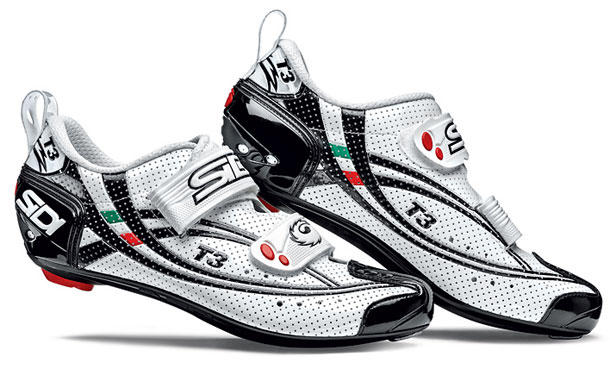
I note that these shoes that have fulcrums built into them – that prescribe where you should pivot and push off – do not try to be universally flexible throughout, back to front. Rather, just as your foot is built to be rigid in some places and flexible and “hinged” in others, these kinds of shoes are likewise rigid where rigidity is thought to be advantageous. These shoes that have purposeful fulcrums are designed to give you an advantage, a head start, and are not unlike the thought behind Osymetric or Rotor chain rings.
What I don’t know is where these fulcrums will eventually be placed. Unless this is a fad that disappears – and I really don’t think it will – the fine-tuning of this pivot in the shoe becomes an interesting question. Should it be angled, like Asics’ Fluidaxis flex grooves? Where should it be placed, front to back? How long should the pivot platform be, front to back?
Midsole Wrap
This is, to me, the most exciting feature of Hoka’s shoes and I hope other shoe companies figure this out. Let me be clear, Hoka shoes are ultra, ultra supportive for overpronators and those who need lateral stability, while being absolutely bereft of stability “technologies.” Yes, Hokas are soft and cushiony and, yes, that’s in large part due to thicknesses of 30mm and 35mm in the heel and, even more importantly, 25mm to 30mm in the forefoot. But it’s easy to take all that cushioning and flush it down the toilet through employing medial stability features such as dual-density midsoles, and rigid plastic plugs on the medial side of the shoe.
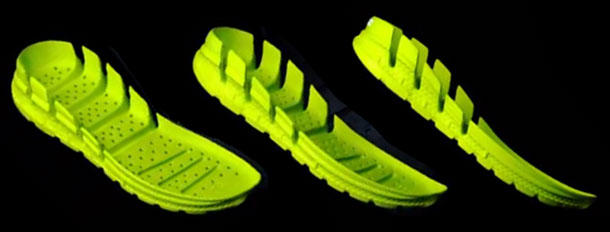
Let me ask you, what happens to the suspension in your MTB bike when you lock it out? How soft is it then? Not very! So, if you put a nice cushiony EVA in your midsole and then you lock it out via a plastic insert that keeps the shoe from compressing, how plush is that ride?
I think Newton and Hoka are converging in important ways. Hoka and Newton are already thematically similar, I think, in their attention to fulcrums in shoes. Hoka is coming Newton’s way with shoes like the Clifton which, at sub-7oz, is a flat that can be raced by anybody, any weight, any race on the road. Newton is coming Hoka’s way by widening its base of support, increasing cushion, and drawing down, slightly, the protrusion of its lugs versus the rest of the outsole (see its 5th lug shoes).
But where Newton is not yet coming in Hoka’s direction is the midsole wrap Hoka uses to encase the upper and create an extremely stable shoe without mitigating the cushy ride through a higher density foam on the medial side, or a block or post locking out movement in the medial heel and arch (thankfully, Newton is not using any of those funky technologies either). Hokas do not look like low-drop shoes, from the side. They look like high drop shows. Heck, they look like pumps. But you’re not riding atop all that midsole. You’re riding inside of it. A look at the Conquest from the side and you can see how far the heel is sunk inside that shoe (the footbed sits roughly atop that red line superimposed on the shoe below). This is the shoe of the future. This is the way shoes need to be built. It’s the way some shoes have been built, but, Hoka literally broke the mold. This is the kind of construction that we need to see more of.
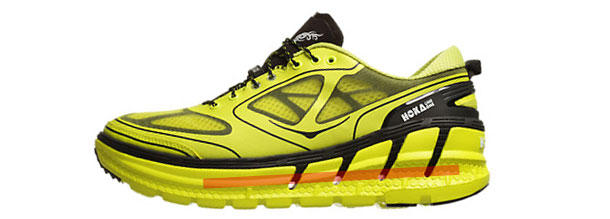
This is why, when you ask people from Hoka, “Is the Bondi and the Conquest a neutral shoe?” some of them will say, “Yes.” And it is, because it employs none of these counterproductive technologies and features that protect the midsole from collapsing on the medial side, but do not protect the heel cup and arch – above the midsole – from collapsing on the medial side. These so-called stability shoes have neither cushioning nor stability. But when you ask other people at Hoka, “is the Bondi and the Conquest a stability or motion control shoe?” they might say yes, because your foot’s lateral motion is absolutely controlled. It’s just not controlled by the traditional footwear technologies used to control motion.
Now, to be fair, you can certainly find examples of motion control shoes that have used this technique of wrapping the midsole up and around the foot from the arch back around the heel. The problem is that these shoes run like you’re running in both the shoes and the boxes they came in. they’re heavy, uncomfortable, clumsy. Those of us who’ve wanted the sprightly, quick shoe that used this technique were out of luck.
No arch cutaway
It’s important for shoe designers to abandon this idea that the shoe needs to twist or flex around their long axis. They don’t. But when you build in this functionality in the mistaken view that they do, the bending moment is in the neighborhood of the arch. That’s the place that these shoe designers make their product pliable and vulnerable to twisting. Large shoe companies, from time to time, decide to resurrect this idea that shoes need to twist, and when they do they hog out the midsole in the area of the arch, and this robs the shoe of the ability to withstand the crushing power of the runner’s body weight as he plants and weights the shoe. This is no problem for those with naturally pretty footfalls. It’s horrible for overpronaters.
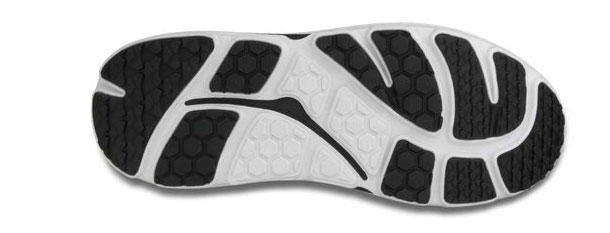
This is the outsole of a Bondi 3. It is not sculpted under the arch. This gives this shoe the ability to withstand the pressure in the arch area – pressure consisting of the runner’s body weight increased depending on the velocity at the point of footplant. When you look at this picture, you think argh! This is the Waffle Trainer all over again, with a big board on the inside mimicking the look of the outsole! Not so. Looking inside the shoe from the top down it looks like a curve lasted shoe. But looking at this view, from the bottom up, it looks like a straight lasted shoe. Clever.
Forefoot cushion
No sooner does a footwear company make a shoe that has forefoot cushioning than they backslide. Adidas Rotterdam (early 2000s), Nike Air Mariah (1990 or thereabouts), and an excellent shoe from Reebok, maybe it was the London TC, I believe Steve Jones wore this to a 2:08:05 in Chicago, setting a WR, these are examples.
My problem was heel to toe drop, but just important was the solution. Do not lower the heel, raise the forefoot! Happily, this is what these companies are doing. This is another area where Newton, maybe unwittingly, and Hoka are converging. By adding its 5th lug Newton says it has increased its cushioning 25 percent. Where? In the forefoot. Bravo! Now, this does not precisely sync with the historic narrative from Danny Abshire, the soul of Newton, who has been suspicious of anything that interrupts the foot’s communication with the ground. No matter. To me, this is a no-brainer. Forefoot cushion is the way of the future. Hoka has it. Newton is heading in that same direction. Others have to get there quickly, or they’re just going to lose market share.
And I think we see this from Brooks (Pure Project), Saucony (Kinvara), and others, do we not? By raising the forefoot, drop is reduced and forefoot cushion is increased. My only quarrel is that these shoes often tend not to have their midsoles wrap the upper, hence these new kinds of shoes follow “natural” running when they should recognize that these shoes severely circumscribe their customer base by not supporting the foot side-to-side.
Let me place this in perspective. Saucony and Brooks sit above Hoka among Slowtwitchers, and Newton is right with Hoka. Newtons, Brooks Pure Project series, Saucony's Kinvara, these shoes do not employ this kind of midsole wrap and they sell equal or better than Hokas. So, how necessary can this feature be? Not necessary at all. You don't need it at all. Unless you do. If you have a good footfall, you don't need lateral-medial stability features. My reason for harping on this as a feature of the future is that you give up very little to have this feature. If you don’t think you need the midsole wrapping your upper, because you don’t overpronate, this does not hurt you. If you don’t overpronate, you don’t “use” that feature. You don’t stress the shoe that way. Now, a typical motion control shoe, yes, if you’re a neutral runner the features historically put into a shoe to guard against overpronation will compromise the shoe’s performance. But not a midsole wrap. That does not "lock out" the shoe's "suspension" or add a bunch of weight.
I’m opinionated about these things, but you can’t call me inconsistent. This is 2014, and 11 years ago, in this overview of semi-racing flats we might use in a triathlon I wrote this: “I require a pretty soft shoe, especially one that's soft in the forefoot. For some reason, shoe makers tend toward wedging their shoes high in the heel and low in the forefoot. I hate this. If I wanted my shoes built this way I'd buy pumps. One reason why the Rotterdam works for me is that its forefoot midsole is sufficiently thick. This makes the forefoot comfy, and keeps my achilles tendons sufficiently elongated.”
We are now at the point, finally, and for the first time in the history of running shoes, where midsole wrap, forefoot cushioning, cushioning in general, low heel-to-toe drop, and attention to shoe geometry, are all prized as features by shoe designers. Shoe designers are no longer majoring in the minors; they are fixed on the features that make a difference.


